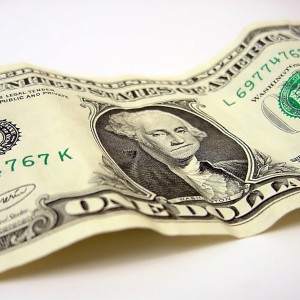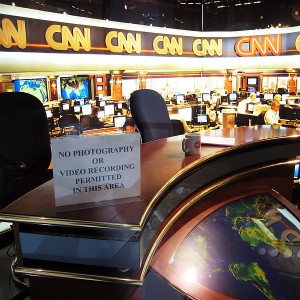 37 million Americans currently have outstanding student loans, and the delinquency rate on those student loans has now reached a level never seen before. According to a new report that was just released by the U.S. Department of Education, 11 percent of all student loans are at least 90 days delinquent. That is a brand new record high, and it is almost double the rate of a decade ago. Total student loan debt exceeds a trillion dollars, and it is now the second largest category of consumer debt after home mortgages. The student loan debt bubble has been growing particularly rapidly in recent years. According to the Federal Reserve, the total amount of student loan debt has risen by 275 percent since 2003. That is a staggering figure. Millions upon millions of young college graduates are entering the “real world” only to discover that they are already financially crippled for decades to come by oppressive student loan debt burdens. Large numbers of young people are even putting off buying homes or getting married simply because of student loan debt. (Read More...)
37 million Americans currently have outstanding student loans, and the delinquency rate on those student loans has now reached a level never seen before. According to a new report that was just released by the U.S. Department of Education, 11 percent of all student loans are at least 90 days delinquent. That is a brand new record high, and it is almost double the rate of a decade ago. Total student loan debt exceeds a trillion dollars, and it is now the second largest category of consumer debt after home mortgages. The student loan debt bubble has been growing particularly rapidly in recent years. According to the Federal Reserve, the total amount of student loan debt has risen by 275 percent since 2003. That is a staggering figure. Millions upon millions of young college graduates are entering the “real world” only to discover that they are already financially crippled for decades to come by oppressive student loan debt burdens. Large numbers of young people are even putting off buying homes or getting married simply because of student loan debt. (Read More...)
Basel III: How The Bank For International Settlements Is Going To Help Bring Down The Global Economy
 A new set of regulations that most people have never even heard of that was developed by an immensely powerful central banking organization that most people do not even know exists is going to have a dramatic effect on the global financial system over the next several years. The new set of regulations is known as “Basel III”, and it was developed by the Bank for International Settlements. The Bank for International Settlements has been called “the central bank for central banks”, and it is headquartered in Basel, Switzerland. 58 major central banks (including the Federal Reserve) belong to the Bank for International Settlements, and the decisions made in Basel often have more of an impact on the direction of the global economy than anything the president of the United States or the U.S. Congress are doing. All you have to do is to look back at the last financial crisis to see an example of this. Basel II and Basel 2.5 played a major role in precipitating the subprime mortgage meltdown. Now a new set of regulations known as “Basel III” are being rolled out. The implementation of these new regulations is beginning this year, and they will be completely phased in by 2019. These new regulations dramatically increase capital requirements and significantly restrict the use of leverage. Those certainly sound like good goals, the problem is that the entire global financial system is based on credit at this point, and these new regulations are going to substantially reduce the flow of credit. The only way that the giant debt bubble that we are all living in can continue to persist is if it continues to expand. By restricting the flow of credit, these new regulations threaten to burst the debt bubble and bring down the entire global economy. (Read More...)
A new set of regulations that most people have never even heard of that was developed by an immensely powerful central banking organization that most people do not even know exists is going to have a dramatic effect on the global financial system over the next several years. The new set of regulations is known as “Basel III”, and it was developed by the Bank for International Settlements. The Bank for International Settlements has been called “the central bank for central banks”, and it is headquartered in Basel, Switzerland. 58 major central banks (including the Federal Reserve) belong to the Bank for International Settlements, and the decisions made in Basel often have more of an impact on the direction of the global economy than anything the president of the United States or the U.S. Congress are doing. All you have to do is to look back at the last financial crisis to see an example of this. Basel II and Basel 2.5 played a major role in precipitating the subprime mortgage meltdown. Now a new set of regulations known as “Basel III” are being rolled out. The implementation of these new regulations is beginning this year, and they will be completely phased in by 2019. These new regulations dramatically increase capital requirements and significantly restrict the use of leverage. Those certainly sound like good goals, the problem is that the entire global financial system is based on credit at this point, and these new regulations are going to substantially reduce the flow of credit. The only way that the giant debt bubble that we are all living in can continue to persist is if it continues to expand. By restricting the flow of credit, these new regulations threaten to burst the debt bubble and bring down the entire global economy. (Read More...)
The Japanese Financial System Is Beginning To Spin Wildly Out Of Control
 The financial system of the third largest economy on the planet is starting to come apart at the seams, and the ripple effects are going to be felt all over the globe. Nobody knew exactly when the Japanese financial system was going to begin to implode, but pretty much everyone knew that a day of reckoning for Japan was coming eventually. After all, the Japanese economy has been in a slump for over a decade, Japan has a debt to GDP ratio of well over 200 percent and they are spending about 50 percent of all tax revenue on debt service. In a desperate attempt to revitalize the economy and reduce the debt burden, the Bank of Japan decided a few months ago to start pumping massive amounts of money into the economy. At first, it seemed to be working. Economic activity perked up and the Japanese stock market went on a tremendous run. Unfortunately, there is also a very significant downside to pumping your economy full of money. Investors start demanding higher returns on their money and interest rates go up. But the Japanese government cannot afford higher interest rates. Without super low interest rates, Japanese government finances would totally collapse. In addition, higher interest rates in the private sector would make it much more difficult for the Japanese economy to expand. In essence, pretty much the last thing that Japan needs right now is significantly higher interest rates, but that is exactly what the policies of the Bank of Japan are going to produce. (Read More...)
The financial system of the third largest economy on the planet is starting to come apart at the seams, and the ripple effects are going to be felt all over the globe. Nobody knew exactly when the Japanese financial system was going to begin to implode, but pretty much everyone knew that a day of reckoning for Japan was coming eventually. After all, the Japanese economy has been in a slump for over a decade, Japan has a debt to GDP ratio of well over 200 percent and they are spending about 50 percent of all tax revenue on debt service. In a desperate attempt to revitalize the economy and reduce the debt burden, the Bank of Japan decided a few months ago to start pumping massive amounts of money into the economy. At first, it seemed to be working. Economic activity perked up and the Japanese stock market went on a tremendous run. Unfortunately, there is also a very significant downside to pumping your economy full of money. Investors start demanding higher returns on their money and interest rates go up. But the Japanese government cannot afford higher interest rates. Without super low interest rates, Japanese government finances would totally collapse. In addition, higher interest rates in the private sector would make it much more difficult for the Japanese economy to expand. In essence, pretty much the last thing that Japan needs right now is significantly higher interest rates, but that is exactly what the policies of the Bank of Japan are going to produce. (Read More...)
40 Statistics About The Fall Of The U.S. Economy That Are Almost Too Crazy To Believe
 If you know someone that actually believes that the U.S. economy is in good shape, just show them the statistics in this article. When you step back and look at the long-term trends, it is undeniable what is happening to us. We are in the midst of a horrifying economic decline that is the result of decades of very bad decisions. 30 years ago, the U.S. national debt was about one trillion dollars. Today, it is almost 17 trillion dollars. 40 years ago, the total amount of debt in the United States was about 2 trillion dollars. Today, it is more than 56 trillion dollars. At the same time that we have been running up all of this debt, our economic infrastructure and our ability to produce wealth has been absolutely gutted. Since 2001, the United States has lost more than 56,000 manufacturing facilities and millions of good jobs have been shipped overseas. Our share of global GDP declined from 31.8 percent in 2001 to 21.6 percent in 2011. The percentage of Americans that are self-employed is at a record low, and the percentage of Americans that are dependent on the government is at a record high. The U.S. economy is a complete and total mess, and it is time that we faced the truth. (Read More...)
If you know someone that actually believes that the U.S. economy is in good shape, just show them the statistics in this article. When you step back and look at the long-term trends, it is undeniable what is happening to us. We are in the midst of a horrifying economic decline that is the result of decades of very bad decisions. 30 years ago, the U.S. national debt was about one trillion dollars. Today, it is almost 17 trillion dollars. 40 years ago, the total amount of debt in the United States was about 2 trillion dollars. Today, it is more than 56 trillion dollars. At the same time that we have been running up all of this debt, our economic infrastructure and our ability to produce wealth has been absolutely gutted. Since 2001, the United States has lost more than 56,000 manufacturing facilities and millions of good jobs have been shipped overseas. Our share of global GDP declined from 31.8 percent in 2001 to 21.6 percent in 2011. The percentage of Americans that are self-employed is at a record low, and the percentage of Americans that are dependent on the government is at a record high. The U.S. economy is a complete and total mess, and it is time that we faced the truth. (Read More...)
The Colorado River, The High Plains Aquifer And The Entire Western Half Of The U.S. Are Rapidly Drying Up
 What is life going to look like as our precious water resources become increasingly strained and the western half of the United States becomes bone dry? Scientists tell us that the 20th century was the wettest century in the western half of the country in 1000 years, and now things appear to be reverting to their normal historical patterns. But we have built teeming cities in the desert such as Phoenix and Las Vegas that support millions of people. Cities all over the Southwest continue to grow even as the Colorado River, Lake Mead and the High Plains Aquifer system run dry. So what are we going to do when there isn’t enough water to irrigate our crops or run through our water systems? Already we are seeing some ominous signs that Dust Bowl conditions are starting to return to the region. In the past couple of years we have seen giant dust storms known as “haboobs” roll through Phoenix, and 6 of the 10 worst years for wildfires ever recorded in the United States have all come since the year 2000. In fact, according to the Los Angeles Times, “the average number of fires larger than 1,000 acres in a year has nearly quadrupled in Arizona and Idaho and has doubled in every other Western state” since the 1970s. But scientists are warning that they expect the western United States to become much drier than it is now. What will the western half of the country look like once that happens? (Read More...)
What is life going to look like as our precious water resources become increasingly strained and the western half of the United States becomes bone dry? Scientists tell us that the 20th century was the wettest century in the western half of the country in 1000 years, and now things appear to be reverting to their normal historical patterns. But we have built teeming cities in the desert such as Phoenix and Las Vegas that support millions of people. Cities all over the Southwest continue to grow even as the Colorado River, Lake Mead and the High Plains Aquifer system run dry. So what are we going to do when there isn’t enough water to irrigate our crops or run through our water systems? Already we are seeing some ominous signs that Dust Bowl conditions are starting to return to the region. In the past couple of years we have seen giant dust storms known as “haboobs” roll through Phoenix, and 6 of the 10 worst years for wildfires ever recorded in the United States have all come since the year 2000. In fact, according to the Los Angeles Times, “the average number of fires larger than 1,000 acres in a year has nearly quadrupled in Arizona and Idaho and has doubled in every other Western state” since the 1970s. But scientists are warning that they expect the western United States to become much drier than it is now. What will the western half of the country look like once that happens? (Read More...)
Will It Be Inflation Or Deflation? The Answer May Surprise You
 Is the coming financial collapse going to be inflationary or deflationary? Are we headed for rampant inflation or crippling deflation? This is a subject that is hotly debated by economists all over the country. Some insist that the wild money printing that the Federal Reserve is doing combined with out of control government spending will eventually result in hyperinflation. Others point to all of the deflationary factors in our economy and argue that we will experience tremendous deflation when the bubble economy that we are currently living in bursts. So what is the truth? Well, for the reasons listed below, I believe that we will see both. The next major financial panic will cause a substantial deflationary wave first, and after that we will see unprecedented inflation as the central bankers and our politicians respond to the financial crisis. This will happen so quickly that many will get “financial whiplash” as they try to figure out what to do with their money. We are moving toward a time of extreme financial instability, and different strategies will be called for at different times. (Read More...)
Is the coming financial collapse going to be inflationary or deflationary? Are we headed for rampant inflation or crippling deflation? This is a subject that is hotly debated by economists all over the country. Some insist that the wild money printing that the Federal Reserve is doing combined with out of control government spending will eventually result in hyperinflation. Others point to all of the deflationary factors in our economy and argue that we will experience tremendous deflation when the bubble economy that we are currently living in bursts. So what is the truth? Well, for the reasons listed below, I believe that we will see both. The next major financial panic will cause a substantial deflationary wave first, and after that we will see unprecedented inflation as the central bankers and our politicians respond to the financial crisis. This will happen so quickly that many will get “financial whiplash” as they try to figure out what to do with their money. We are moving toward a time of extreme financial instability, and different strategies will be called for at different times. (Read More...)
America’s Bubble Economy Is Going To Become An Economic Black Hole
 What is going to happen when the greatest economic bubble in the history of the world pops? The mainstream media never talks about that. They are much too busy covering the latest dogfights in Washington and what Justin Bieber has been up to. And most Americans seem to think that if the Dow keeps setting new all-time highs that everything must be okay. Sadly, that is not the case at all. Right now, the U.S. economy is exhibiting all of the classic symptoms of a bubble economy. You can see this when you step back and take a longer-term view of things. Over the past decade, we have added more than 10 trillion dollars to the national debt. But most Americans have shown very little concern as the balance on our national credit card has soared from 6 trillion dollars to nearly 17 trillion dollars. Meanwhile, Wall Street has been transformed into the biggest casino on the planet, and much of the new money that the Federal Reserve has been recklessly printing up has gone into stocks. But the Dow does not keep setting new records because the underlying economic fundamentals are good. Rather, the reckless euphoria that we are seeing in the financial markets right now reminds me very much of 1929. Margin debt is absolutely soaring, and every time that happens a crash rapidly follows. But this time when a crash happens it could very well be unlike anything that we have ever seen before. The top 25 U.S. banks have more than 212 trillion dollars of exposure to derivatives combined, and when that house of cards comes crashing down there is no way that anyone will be able to prop it back up. After all, U.S. GDP for an entire year is only a bit more than 15 trillion dollars. (Read More...)
What is going to happen when the greatest economic bubble in the history of the world pops? The mainstream media never talks about that. They are much too busy covering the latest dogfights in Washington and what Justin Bieber has been up to. And most Americans seem to think that if the Dow keeps setting new all-time highs that everything must be okay. Sadly, that is not the case at all. Right now, the U.S. economy is exhibiting all of the classic symptoms of a bubble economy. You can see this when you step back and take a longer-term view of things. Over the past decade, we have added more than 10 trillion dollars to the national debt. But most Americans have shown very little concern as the balance on our national credit card has soared from 6 trillion dollars to nearly 17 trillion dollars. Meanwhile, Wall Street has been transformed into the biggest casino on the planet, and much of the new money that the Federal Reserve has been recklessly printing up has gone into stocks. But the Dow does not keep setting new records because the underlying economic fundamentals are good. Rather, the reckless euphoria that we are seeing in the financial markets right now reminds me very much of 1929. Margin debt is absolutely soaring, and every time that happens a crash rapidly follows. But this time when a crash happens it could very well be unlike anything that we have ever seen before. The top 25 U.S. banks have more than 212 trillion dollars of exposure to derivatives combined, and when that house of cards comes crashing down there is no way that anyone will be able to prop it back up. After all, U.S. GDP for an entire year is only a bit more than 15 trillion dollars. (Read More...)
7 Things About The Mainstream Media That They Do Not Want You To Know
 Have you ever wondered who controls the mainstream media? In America today, we are more “connected” than ever. The average American watches 153 hours of television a month, and we also spend countless hours watching movies, playing video games, listening to music, reading books and surfing the Internet. If someone could control the production of all of that media, that would make them immensely powerful. They would literally be in a position to tell people what to think. Well, what if I told you that there are just six enormous media conglomerates that combine to produce about 90 percent of all the media that Americans consume. Would that alarm you? It should alarm you. The truth is that our attitudes, opinions and beliefs are greatly shaped by what we allow into our minds. After all, they don’t call it “programming” for no reason. Even those of us that realize that we are connected to “the matrix” probably greatly underestimate the tremendous influence that the media has over us. We live at a time when it is absolutely imperative to think for ourselves, but most Americans are being absolutely overwhelmed with information and seem more than content to let others do their thinking for them. Sadly, this is greatly contributing to the downfall of our society. (Read More...)
Have you ever wondered who controls the mainstream media? In America today, we are more “connected” than ever. The average American watches 153 hours of television a month, and we also spend countless hours watching movies, playing video games, listening to music, reading books and surfing the Internet. If someone could control the production of all of that media, that would make them immensely powerful. They would literally be in a position to tell people what to think. Well, what if I told you that there are just six enormous media conglomerates that combine to produce about 90 percent of all the media that Americans consume. Would that alarm you? It should alarm you. The truth is that our attitudes, opinions and beliefs are greatly shaped by what we allow into our minds. After all, they don’t call it “programming” for no reason. Even those of us that realize that we are connected to “the matrix” probably greatly underestimate the tremendous influence that the media has over us. We live at a time when it is absolutely imperative to think for ourselves, but most Americans are being absolutely overwhelmed with information and seem more than content to let others do their thinking for them. Sadly, this is greatly contributing to the downfall of our society. (Read More...)